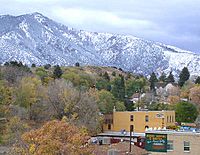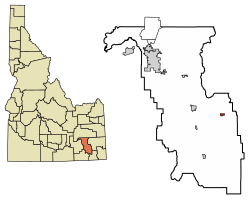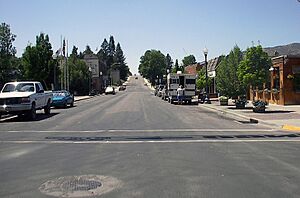Lava Hot Springs, Idaho facts for kids
Quick facts for kids
Lava Hot Springs, Idaho
|
|
|---|---|

Lava Hot Springs, October 2004
|
|

Location of Lava Hot Springs in Bannock County, Idaho.
|
|
| Country | United States |
| State | Idaho |
| County | Bannock |
| Area | |
| • Total | 0.72 sq mi (1.86 km2) |
| • Land | 0.69 sq mi (1.79 km2) |
| • Water | 0.03 sq mi (0.07 km2) |
| Elevation | 5,007 ft (1,526 m) |
| Population | |
| • Total | 358 |
| • Density | 623.38/sq mi (240.79/km2) |
| Time zone | UTC-7 (Mountain (MST)) |
| • Summer (DST) | UTC-6 (MDT) |
| ZIP code |
83246
|
| Area code(s) | 208, 986 |
| FIPS code | 16-45820 |
| GNIS feature ID | 2411635 |
Lava Hot Springs is a small city in Idaho, United States. It's located in eastern Bannock County, right by the Portneuf River. In 2020, about 358 people lived there.
This city is famous for its natural hot springs. People love to visit for relaxing baths in the warm mineral waters. It's also known for a fun inner tube run on the river that goes right through town! Long ago, this area was part of the historic Oregon Trail and California Trail, important routes for pioneers traveling west.
Contents
Exploring Lava Hot Springs' Location
Lava Hot Springs is nestled in a mountainous valley. It's a small place, covering about 0.71 square miles (1.86 square kilometers). Most of this area is land, with a tiny bit of water.
Understanding the Climate in Lava Hot Springs
The weather in Lava Hot Springs changes a lot between seasons. It has a "warm-summer humid continental climate." This means summers are warm and winters are cold, with snow.
The hottest temperature ever recorded here was 102°F (39°C) on July 14, 2002. The coldest temperature was a chilly -22°F (-30°C) on February 1, 2023.
Population and Community Life
Lava Hot Springs is a small community. The number of people living here has changed over the years. In 1920, there were 662 residents, but by 2020, the population was 358.
| Historical population | |||
|---|---|---|---|
| Census | Pop. | %± | |
| 1920 | 662 | — | |
| 1930 | 544 | −17.8% | |
| 1940 | 647 | 18.9% | |
| 1950 | 591 | −8.7% | |
| 1960 | 593 | 0.3% | |
| 1970 | 516 | −13.0% | |
| 1980 | 467 | −9.5% | |
| 1990 | 420 | −10.1% | |
| 2000 | 521 | 24.0% | |
| 2010 | 407 | −21.9% | |
| 2020 | 358 | −12.0% | |
| 2023 (est.) | 375 | −7.9% | |
| U.S. Decennial Census | |||
What the 2010 Census Showed
In 2010, there were 407 people living in Lava Hot Springs. Most residents (97.5%) were White. About 4.2% of the population identified as Hispanic or Latino. The average age of people living in the city was about 50.9 years old.
Getting Around: Transportation Routes
The main road that goes through Lava Hot Springs is U.S. Route 30. This highway passes just north of the town. There's also an older road called Old Highway 30. This used to be the main route but was changed to make travel shorter between towns.
The new route of US 30 made the trip to Soda Springs about 11 miles (18 km) shorter. It also made the drive to Bancroft about 5.5 miles (8.9 km) shorter.
Famous People from Lava Hot Springs
Even though it's a small city, a few notable people have come from Lava Hot Springs:
- Kevin Andrus: He is a member of the Idaho House of Representatives, which is part of the state's government.
- Terrel Bell (1921–1996): He was the second United States Secretary of Education. This means he was in charge of education for the entire country from 1981 to 1984.
See also
 In Spanish: Lava Hot Springs para niños
In Spanish: Lava Hot Springs para niños


